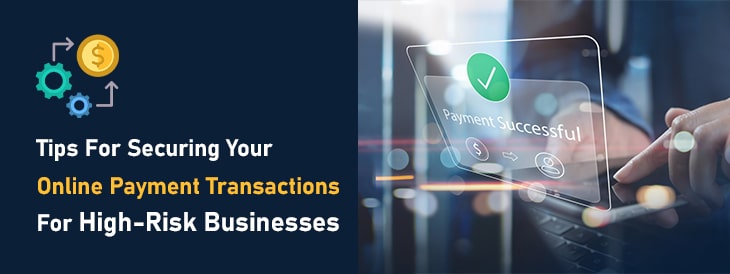Tips For Securing Your Online Payment Transactions For High-Risk Businesses
Tips For Securing Your Online Payment Transactions For High-Risk Businesses

Navigating the world of online payment transactions can be particularly challenging for high-risk businesses. The unique nature of these enterprises often makes them targets for fraud and cyberattacks, necessitating a robust approach to transaction security.
To secure high-risk payments, it is essential to adopt a multifaceted strategy that includes employing advanced encryption technologies, utilizing secure payment gateways, and implementing thorough identity verification processes.
Additionally, businesses should stay informed about the latest threats and trends in online fraud to adapt their security measures accordingly. Educating employees about safe payment practices and regularly updating security protocols can further strengthen defenses against potential breaches.
By prioritizing high-risk transaction security, businesses can not only protect their assets but also build trust with customers, ultimately leading to a more successful online presence
Understanding the Risks Associated with High-Risk Transactions
High-risk transactions are inherently more vulnerable to various types of fraud and cyber threats. One significant risk is chargeback fraud, where customers dispute legitimate transactions, leading to financial losses for the business.
Another prevalent issue is phishing attacks, where attackers use deceptive methods to obtain sensitive information such as credit card details and login credentials. Additionally, high-risk businesses often face increased scrutiny from regulatory bodies, which can lead to severe penalties if compliance standards are not met.
Moreover, these businesses are prime targets for data breaches, where cybercriminals infiltrate systems to steal valuable customer information. Distributed Denial of Service (DDoS) attacks are also a common threat, aimed at overwhelming a business’s online infrastructure, causing downtime and financial losses.
Man-in-the-Middle (MitM) attacks pose another risk, where attackers intercept and potentially alter the communication between the business and its customers.
The volatility of high-risk industries, such as gambling, adult entertainment, and travel, further exacerbates these threats, making it crucial for businesses to implement stringent security measures. Understanding these risks is the first step in developing a comprehensive strategy to safeguard online payment transactions and protect both the business and its customers.
Some Related Blogs
- Pros and Cons of Different Payment Processing Methods
- Finding the Right Kratom Merchant Account
- Essential Tips for Kratom Credit Card Processing Success
- Simplifying Payment Processing for Travel Agencies: Key Options
Implementing Robust Fraud Detection Systems
For high-risk businesses, employing robust fraud detection systems is a critical component of securing online payment transactions. These systems utilize advanced algorithms and machine learning to analyze transaction patterns, detect anomalies, and flag suspicious activities in real-time.
Implementing layered security measures, such as behavioral analytics and device fingerprinting, can enhance the effectiveness of fraud detection by providing a comprehensive view of each transaction. Behavioral analytics helps identify deviations from typical user behavior, while device fingerprinting assesses the characteristics of the devices used to initiate transactions.
In addition to automated systems, manual review processes are essential for verifying flagged transactions and ensuring that legitimate activities are not mistakenly blocked. Fraud detection systems should also be integrated with other security protocols, such as IP geolocation checks and velocity checks, to further refine their accuracy.
Regularly updating and fine-tuning these systems is crucial, as fraudsters continually evolve their tactics. By investing in sophisticated fraud detection technologies, high-risk businesses can significantly reduce the likelihood of fraudulent transactions and safeguard their financial stability.
Ensuring Compliance with Payment Security Standards
Adhering to payment security standards is vital for high-risk businesses to avoid penalties and maintain customer trust. One crucial framework is the Payment Card Industry Data Security Standard (PCI DSS), which outlines requirements for secure handling of card information. High-risk businesses must ensure they are PCI DSS compliant by implementing secure network configurations, maintaining a vulnerability management program, and regularly monitoring and testing networks.
Another important standard is the General Data Protection Regulation (GDPR), which mandates the protection of customer data for businesses operating in or dealing with clients from the European Union. Ensuring compliance with GDPR involves obtaining explicit consent from customers for data processing and implementing measures to safeguard personal information.
Additionally, adopting Secure Sockets Layer (SSL) certificates can help encrypt data transmitted between the business and its customers, enhancing overall transaction security. It’s also advisable to stay updated with industry-specific regulations, such as the Federal Financial Institutions Examination Council (FFIEC) guidelines for financial institutions.
By integrating these standards into their security protocols, high-risk businesses can not only mitigate the risks associated with online payment transactions but also build a solid foundation for regulatory compliance. Regular audits and assessments are crucial to ensure ongoing adherence to these standards and to adapt to any regulatory changes.
Utilizing Multi-Factor Authentication (MFA)
Utilizing Multi-Factor Authentication (MFA) is an essential step for high-risk businesses to enhance their online payment transaction security. MFA adds an extra layer of protection by requiring users to provide two or more verification factors to gain access to their accounts.
This typically involves something the user knows, such as a password, combined with something the user has, like a smartphone or a hardware token, and sometimes something the user is, such as a fingerprint or facial recognition. Implementing MFA reduces the likelihood of unauthorized access, as cybercriminals would need to breach multiple layers of security to succeed.
High-risk businesses should integrate MFA into their login and transaction processes to ensure that only authorized users can initiate payments. Additionally, businesses can use adaptive MFA, which assesses the risk level of each login attempt based on various factors like user behavior and location, to provide a more flexible yet secure authentication process.
Ensuring that MFA methods are user-friendly is crucial for encouraging compliance and minimizing disruptions to the customer experience. By making MFA a standard part of their security protocols, high-risk businesses can significantly strengthen their defenses against potential cyber threats.
![]()
Email us anytime!
Email customer service 24/7 at info@binarygateways.com
![]()
Call us anytime!
Reach customer care 24/7 at (801) 761-5001
